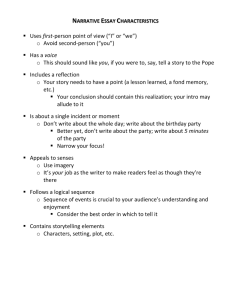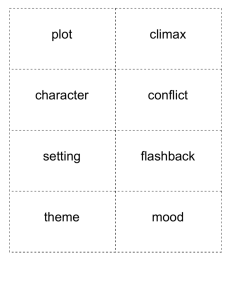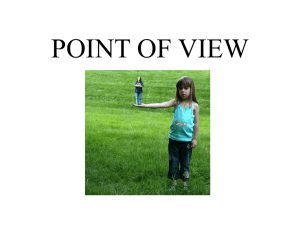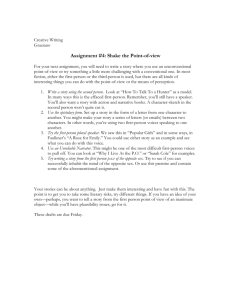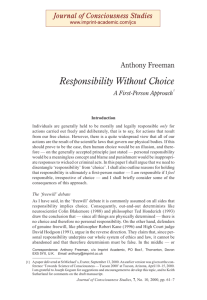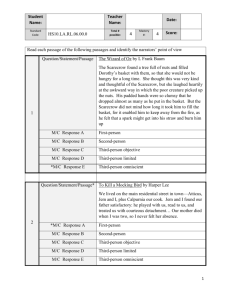First-person Methodologies: What, Why, How?
advertisement
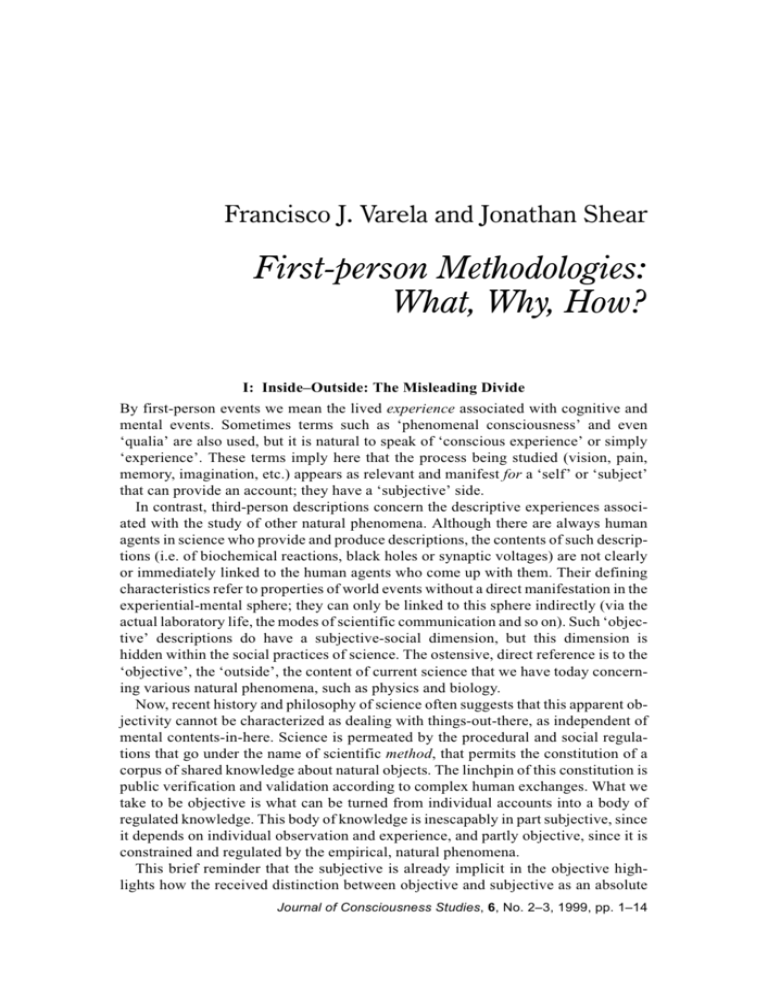
Francisco J. Varela and Jonathan Shear First-person Methodologies: What, Why, How? I: Inside–Outside: The Misleading Divide By first-person events we mean the lived experience associated with cognitive and mental events. Sometimes terms such as ‘phenomenal consciousness’ and even ‘qualia’ are also used, but it is natural to speak of ‘conscious experience’ or simply ‘experience’. These terms imply here that the process being studied (vision, pain, memory, imagination, etc.) appears as relevant and manifest for a ‘self’ or ‘subject’ that can provide an account; they have a ‘subjective’ side. In contrast, third-person descriptions concern the descriptive experiences associated with the study of other natural phenomena. Although there are always human agents in science who provide and produce descriptions, the contents of such descriptions (i.e. of biochemical reactions, black holes or synaptic voltages) are not clearly or immediately linked to the human agents who come up with them. Their defining characteristics refer to properties of world events without a direct manifestation in the experiential-mental sphere; they can only be linked to this sphere indirectly (via the actual laboratory life, the modes of scientific communication and so on). Such ‘objective’ descriptions do have a subjective-social dimension, but this dimension is hidden within the social practices of science. The ostensive, direct reference is to the ‘objective’, the ‘outside’, the content of current science that we have today concerning various natural phenomena, such as physics and biology. Now, recent history and philosophy of science often suggests that this apparent objectivity cannot be characterized as dealing with things-out-there, as independent of mental contents-in-here. Science is permeated by the procedural and social regulations that go under the name of scientific method, that permits the constitution of a corpus of shared knowledge about natural objects. The linchpin of this constitution is public verification and validation according to complex human exchanges. What we take to be objective is what can be turned from individual accounts into a body of regulated knowledge. This body of knowledge is inescapably in part subjective, since it depends on individual observation and experience, and partly objective, since it is constrained and regulated by the empirical, natural phenomena. This brief reminder that the subjective is already implicit in the objective highlights how the received distinction between objective and subjective as an absolute Journal of Consciousness Studies, 6, No. 2–3, 1999, pp. 1–14 2 F.J. VARELA AND J. SHEAR demarcation between inside and outside, needs to be closely scrutinized. Mutatis mutandis, dealing with subjective phenomena is not the same as dealing with purely private experiences, as is often assumed. The subjective is intrinsically open to intersubjective validation, if only we avail ourselves of a method and procedure for doing so. One central purpose of this first-person methodologies Special Issue is, precisely, to survey some major current approaches that attempt to provide the basis for a science of consciousness which includes first-person, subjective experience as an explicit and active component. II: First and Third: The Necessary Circulation Setting the question as we just did, the next point to raise is what is the status of firstperson accounts? In some basic sense, the answer cannot be given a priori, and it can only unfold from actually exploring this realm of phenomena, as is the case in the contributions presented herein. However let us state at the outset some thorny issues, in order to avoid some recurrent misunderstandings. First, exploring first-person accounts is not the same as claiming that first-person accounts have some kind of privileged access to experience. No presumption of anything incorrigible, final, easy or apodictic about subjective phenomena needs to be made here, and to assume otherwise is to confuse the immediate character of the givenness of subjective phenomena with their mode of constitution and evaluation. Much wasted ink could have been saved by distinguishing the irreducibility of firstperson descriptions from their epistemic status. Second, a crucial point in this Special Issue has been to underline the need to overcome the ‘just-take-a-look’ attitude in regards to experience. The apparent familiarity we have with subjective life must give way in favour of the careful examination of what it is that we can and cannot have access to, and how this distinction is not rigid but variable. It is here that methodology appears as crucial: without a sustained examination we actually do not produce phenomenal descriptions that are rich and subtly interconnected enough in comparison to third-person accounts. The main question is: How do you actually do it? Is there evidence that it can be done? If so, with what results? Third, it would be futile to stay with first-person descriptions in isolation. We need to harmonize and constrain them by building the appropriate links with third-person studies. In other words we are not concerned with yet another debate about the philosophical controversies surrounding the first-person/third-person split, (a large body of literature notwithstanding). To make this possible we seek methodologies that can provide an open link to objective, empirically based description. (This often implies an intermediate mediation, a second-person position, as we shall discuss below.) The overall results should be to move towards an integrated or global perspective on mind where neither experience nor external mechanisms have the final word. The global perspective requires therefore the explicit establishment of mutual constraints, a reciprocal influence and determination (Varela, 1996). In brief our stance in regards to first-person methodologies is this: don’t leave home without it, but do not forget to bring along third-person accounts as well. This down-to-earth pragmatic approach gives the tone to the contributions that follow. On the whole, what emerges from this material is that, in spite of all kinds of received ideas, repeated unreflectingly in recent literature of philosophy of mind and FIRST-PERSON METHODOLOGIES: WHY, WHAT & HOW? 3 cognitive science, first-person methods are available and can be fruitfully brought to bear on a science of consciousness. The proof of the pudding is not in a priori arguments, but in actually pointing to explicit examples of practical knowledge, in case studies. III: The Notion of Phenomenal Data The notion of phenomenal data can provide a common first-person/third-person ground for the methodological questions just raised, and therefore a brief discussion of it is in order here, given its key role in this Special Issue. A large body of modern literature addresses the ‘explanatory gap’ between computational and phenomenological mind,1 to use Jackendoff’s terminology (1987). The latter is variously phrased, as we already said, in terms of subjectivity, consciousness, or experience. It is important to examine these different concepts and see how they relate to the more basic one of phenomenal data (Roy et al., 1998). In spite of the variety of terminology being used, a consensus seems to have emerged that Thomas Nagel’s expression ‘what it is like to be’ succeeds in capturing well what is at stake. Clearly ‘what it is like to be’ a bat or a human being refers to how things (everything) looks when being a bat or a human being. In other words this is just another way of talking about what philosophers have called phenomenality since the Presocratics. A phenomenon, in the most original sense of the word, is an appearance and therefore something relational. It is what something is for something else; it is a being for by opposition to a being in itself independently of its apprehension by another entity. Phenomenality certainly is a crucial fact for the domain of living beings. It would for instance surely seem to be the case that an organism with a sonar system like the bat does not perceive what an organism equipped with a visual system like man can perceive: the external world presumably looks very different to both. Similarly, although to a lesser extent, the experience of two individuals belonging to the same species can be expected to differ. Accordingly, it is fair to say that — as advocates of the explanatory gap argument complain — cognitive science often appears to be a theory of mind that leaves phenomenality or subjectivity out, either because it does not attempt to account for it or because it fails to account for it adequately. These notions need further refinement, however, to really capture the point at stake. And this is where the notion of consciousness needs to step in. The progress of cognitive science (as well as the development of psychoanalysis) has made familiar the idea that something might happen for a subject, and in that sense be subjective, but nevertheless not be accessible to this subject. We naturally describe such a case by saying that the subject is not conscious of the phenomenon in question. A distinction must therefore be introduced between conscious and non-conscious phenomena, or again between conscious and sub-personal subjectivity. The notion of consciousness [1] We are using in this article a three-fold distinction between phenomenal, phenomenological and Phenomenology. The first, a broad and general term used in both third- and first-person discussion, refers to whatever is available for examination. It is defined in this section. ‘Phenomenological’ has been used repeatedly in a general sense to designate conscious experience and subjectivity (e.g. by R. Jackendoff, in his pioneering work, and by some of the contributors to this special issue).This broad use of the word is linked to the previous one, and is to be sharply distinguished from work based on the philosophical tradition of Phenomenology, where a ‘phenomenological’ description is necessarily based on ‘reduction’ as presented in the papers in Section II of this issue. 4 F.J. VARELA AND J. SHEAR itself is clearly meant primarily to designate the fact that the subject knows about, is informed about, or in other words is aware of, the phenomenon. It might be tempting to conflate the two concepts of phenomenal data and conscious subjectivity. But the notion of non-conscious or subpersonal phenomena argues against that move: there are, for example, numerous instances where we perceive phenomena pre-reflectively without being consciously aware of them, but where a ‘gesture’ or method of examination will clarify or even bring these pre-reflexive phenomena to the fore. What is being objected to here is the naive assumption that the demarcation line between the strictly subpersonal and the conscious is fixed. It surely has not escaped the reader that this entire Issue is based on the conclusion (assumption) that lived experience is irreducible, that is, that phenomenal data cannot be reduced or derived from the third-person perspective. We are, of course, well aware that the issue is far from consensual,2 and it would be superficial to try and settle it here. However, it is only fair to give the reader the three main bases on which the assumption of irreducibility of experience is cast. First, to accept experience as a domain to be explored is to accept the evidence that life and mind includes that first-person dimension which is a trademark of our ongoing existence. To deprive our scientific examination of this phenomenal realm amounts to either amputating human life of its most intimate domains, or else denying science explanatory access to it. In both cases the move is unsatisfactory. Second, subjective experience refers to the level of the user of one’s own cognitions, of intentions and doings, in everyday practices. I know that my movements are the products of coordinated series of muscle contractions. However, the activity of moving my hand operates on the emergent scale of motor plans that appear to me as motor intentions as an active agent-user, not the muscle tones that can only be seen from a third-person position. This practical dimension is what makes interaction with third-person accounts possible in the first place (and not an abstract armchair description so familiar in philosophy of mind). Third, experience in human practices is the privileged entry point for change mediated by professional interventions of all kinds, such as education and learning, sports training, and psychotherapy. In all these domains there is abundant evidence not only that the realm of experience is essential for human activity and life involving the use of one’s own mind, but that the experiential domain can be explored, as we see in transformations mediated by specific practices and human interactions in prescribed settings (training course, sports coaching, psychotherapeutic sessions). Again, we need to put into question the assumption that the demarcation line between the strictly subpersonal and conscious are fixed and given once and forever. First-person methodologies include as a fundamental dimension the claim that this is a movable line, and much can be done with the intermediate zone. Exploring the pre-reflexive represents a rich and largely unexplored source of information and data with dramatic consequences. [2] For a recent survey of arguments pro and con, see Shear (1997). FIRST-PERSON METHODOLOGIES: WHY, WHAT & HOW? 5 IV: What the Reader Will Find in this Special Issue Having covered the basic ground, it is now time to make a brief guided tour of the material presented in this Special Issue. We have retained three extant methodological traditions, which give rise to three sections: · Section I: the introspective approach, derived from scientific psychology; · Section II: the method of phenomenological reduction, derived from the philosophical tradition of Phenomenology and phenomenological psychology; · Section III: the pragmatics of meditation practices derived from the Buddhist and Vedic traditions. The opening article in Section I by Pierre Vermersch sets the tone for the entire enterprise. He traces the early history of the disciplined use of introspection in psychology back to the origins of scientific psychology, and the much maligned schools of Introspectionism linked to the names of Wundt and Titchener, among others. Vermersch’s point is clear: when we go back to see what they actually did (instead of relying on secondary sources) we can hardly fault these researchers for their spirit of innovation, methodological rigour, or wealth of empirical observations. The question remains: why is it that they did not give rise to a whole tradition of work linking eventually to contemporary cognitive science? The answer is bound to be complex, but one of the key points Vermersch notes is that those researchers were tricked by the apparent simplicity of the task, which obscures the necessary subtle know-how, including the important role of mediation. Claire Peugeot takes up where Vermersch leaves off, exploring a specific example that shows in detail how the difficulties appear, and what kind of methods can be fostered to overcome them. She has chosen to address a thorny but important issue: intuitive experience. The results she presents are a testimony that careful introspective methods are an essential component to explore the experiential. Finally, in this Section we give voice to a more hands-on account of bodywork by Carl Ginsburg, where introspection plays a role, not as a research tool, but in the area of applied disciplines such as education, therapy, management and so on. In fact, it is these areas that embody the richest sources of practical knowledge about human experience articulated over the past half century. Ginsburg brings in some of the key elements of the how and the why of a client’s interest in working with his/her lived experience in the tradition of somatic transformation initiated by Moshe Feldenkrais. Section II is based on the most important western school of thinking where experience and consciousness is at the very heart: Phenomenology as inaugurated by Edmund Husserl at the turn of the century and elaborated in various directions since. The main purpose of Natalie Depraz’s opening paper, however, is to expose the basis of the method that inaugurates phenomenology, phenomenological reduction. To the extent that reduction is linked to introspective gesture and that phenomenology is concerned with experiential content, the intercrossing between this philosophical tradition and introspective psychology is evident. Depraz shows how reduction is a practice that is oriented to the needs of philosophical analysis and yet interleaves with (phenomenological) psychology. The main difference between introspective psychology and phenomenology is one of intent. The psychologist is motivated by research, seeks protocols and objects that can be isolated in the laboratory, and also to establish 6 F.J. VARELA AND J. SHEAR empirical results that can be linked to neural correlates. The phenomenologist is interested in the same mental content in order to explore their broader meaning and place in ordinary human areas such as temporality, intersubjectivity and language. From this perspective Francisco Varela tries to address the experience of present time consciousness in human temporality, with an eye for its bridges to natural science. What is central in this contribution is whether the phenomenal description can help us both validate and constrain the empirical correlates that are available with the modern tools of cognitive neuroscience and dynamical systems theory. The work of William James is justly cited as a source for much of the revival of interest in the psychology of consciousness; it provides an introspectionism or phenomenology of its own kind. Andrew Bailey’s contribution brings to light how this Jamesian approach to the first-person is manifest in his studies on inner time as ‘transitional parts’ of the stream of consciousness. The links and discrepancies with other methods highlighted in this special issue have yet to be drawn more precisely. The contribution by Jean Naudin and his colleagues addresses analogous issues in the realm of human communication in psychiatry. Their point is that in particular the schizophrenic experience induces a form of reduction that the physician must work with in order to enter into his or her role as a therapist. Here is another case of human practices rather than research where first-person methods seem important. In Section III Alan Wallace presents an account of the pragmatics of a fundamental practice in the Buddhist tradition, mindfulness sitting practice (samatha) and its gradual unfolding into its ‘natural’ state devoid of habitual conceptualizations (mahamudra). We can completely put aside in this Special Issue the motivation and values underlying such Buddhist practice and traditions. The point is to emphasize that for their own reasons the Buddhist traditions have accumulated a vast amount of expertise in training the mind and cultivating its ability for reflection and introspection. It has done so over centuries, and expressed some of its observation in terms that are not too far removed from either introspective psychology or phenomenological psychology (according to whom we read). It would be a great mistake of western chauvinism to deny such observations as data and their potential validity. The attempt to integrate Eastern meditation practices and their results into Western culture, however, raises serious problems of interpretation and empirical validation. Jonathan Shear’s and Ronald Jevning’s contribution addresses precisely this issue. In it they examine reports of ‘pure consciousness’ experiences associated with Transcendental Meditation (TM) and Zen Buddhist meditation procedures in terms of cross-cultural, cross-tradition congruencies of the verbal reports, and of laboratory examination of their physiological correlates. V: The Notion of a Method We can at this point begin to see for all these traditions what a method is. At this first stage of approximation we can say that there are at least two main dimensions that need to be present in order for a method to count as such: (1) Providing a clear procedure for accessing some phenomenal domain. (2) Providing a clear means for an expression and validation within a community of observers who have familiarity with procedures as in (1). FIRST-PERSON METHODOLOGIES: WHY, WHAT & HOW? 7 Keeping in mind that the distinction between experiencing (following a procedure), and validation (following a regulated intersubjective exchange) is not an absolute one, the material presented can be outlined thus: Method Procedure Validation 1 Introspection Attention during a defined task Verbal accounts, mediated 2 Phenomenology Reduction-suspension Descriptive invariants 3 Meditation: Samatha; Mahamudra; Zen; TM Sustained attention; uncontrived awareness; suspension of mental activity Traditional accounts, scientific accounts We should of course add that this table is only a cross-section of current knowledge, and there should be no hesitation to evaluate the methods’ relative strengths and weakness. Tentatively we would at present evaluate them thus: Evaluation of procedure Evaluation of validation 1 Medium, needs improvement Medium, good use of protocols 2 Medium, needs improvement Medium, some useful examples 3 Good, detailed methods Historically rich, sometimes relies too much on inside accounts, some good scientific protocols, more needed In short, our overall conclusion is that enough useful results are already at hand to make a case that such first-person methods are not a chimera. VI: Sketch of a Common Structure3 Content and mental act Implicit in our presentation so far is that all these methods can be legitimately brought into register to the extent that they do have some core structures in common. It is now time to try and provide some pointers for such commonalities. Let us consider the situation of a subject in an experimental situation, requested to perform an explicit task. During the accomplishment of this task the person experiences something, and following Vermersch (this issue), we shall call that its lived content, L1, a reference for what will follow. In the context of the task, the subject (with or without mediation) is then required to examine (describe, analyse, and/or become aware of, attend to) L1. For this to happen, within a short time L1 will then become part of the content of a new experience: examining one’s own mentation, a new content, L2, which is a product of the act of noticing one’s own mentation, and L2 will typically have additional new content characterized by the particular manner of access to L1. Notice that for the pair L1–L2 to appear, there is necessarily a redirec[3] This section borrows very significantly from a forthcoming book that Francisco Varela has written in collaboration with Natalie Depraz and Pierre Vermersch. Many thanks to both of them for allowing some of these ideas to be presented in this Introduction (Depraz et al., forthcoming). 8 F.J. VARELA AND J. SHEAR tion of thought, a suspension, an interruption of the natural attitude which normally does not stop to access its own contents.4 The core element appearing in this layering, which is common to all first-person methods, is the clear distinction between the content of a mental act (for instance I am requested to picture my house) and the process through which such content appears (how do I come up with the image being requested). Not keeping this fundamental distinction in view is a source of much confusion. To be sure, the methods listed above show some differences. The first two types involve a focused attention to content, oriented towards gaining some knowledge or insight. Thus the successful learning of a method is here always concomitant to internalizing such doubling from L1 to L2 with ease. Methods of the third and fourth type are more subtle. In early stages of mindfulness (samatha) training, the role of attention to immediate mental content is crucial. But as the practice unfolds, one can relax the initial effort, and content as such becomes less central than the quality of conscious presence itself, as emphasized in the Mahamudra-Dzogchen techniques.The Vedic TM tradition, Dzogchen and Zen Buddhism, and some practices in Vajrayana Buddhism, are from the outset unconcerned with content (above and beyond what is needed for the method itself to be performed). Here the aim is to develop the method until it annihilates itself, yielding states of ‘pure’ (contentless) consciousness. It should be noted that the methods represented here often yield first-person accounts that seem flat and poor. This is one of the recurrent complaints of those who criticize first-person accounts, and they are not wrong. What is missing here is the continuation of the process that involves a shift from the natural attitude where L2 is aimed at directly. This, in turn, mobilizes a second phase that makes it clear that from the initial suspension a new initially void field is progressively filled with new phenomenal data. It is the stage of discovery, or experiential filling-in, and this requires a sustained discipline to accomplish. The apparent facility for access to one’s experience is what is misleading: the filling-in made possible by suspension has its own developmental time which needs cultivation and to be borne patiently. All methods (and individual practitioners), however, have their own developmental time, which can vary greatly. Second-person The establishment of a method then requires the creation of means to go beyond these difficulties. Again each tradition has come up with different means, and they vary substantially. All of them, however, share a common discovery, namely, that in any case the progress in becoming familiar with a particular method requires mediation. By mediation we mean here another person(s) who provides a curious intermediate position between first and second position, whence the name second-person position. A mediator is eccentric to the lived experience L1 but nevertheless takes a position of one who has been there to some degree, and thus provides hints and further training. [4] Even less common is the possibility of going to yet a third step, where L2 becomes the object of an experience, L3, the introspection of introspection. Contrary to a first impression this is not infinite regress: since all this is happening in a brief period of time, the levels of examination stop there, since experience shows clearly that L2 is already an effort, and for L3 to appear one needs a highly trained sustained attention! FIRST-PERSON METHODOLOGIES: WHY, WHAT & HOW? 9 The second-person position is given prominence in all the traditions invoked in this Special Issue, with the exception of the natural sciences where it appears only when the social process of learning is analysed, and a researcher seeks the mediation of a more experienced tutor to improve and progress his skill as a scientist. Although it is standard practice to accord importance to the lineage of the training a scientist has followed, attention to such second-person mediation disappears by the time an article is published in a scientific journal. In brief, then, the three positions (first-, second-, third-) are structured not so much in regards to what content they address, but in the manner in which they appear — inserted in the network of social exchanges. It is the particular roles social agents take in each case that determines their belonging to one or the other position, with gradations. We are therefore not concerned with a dual opposition between the private and the public, or the objective and the subjective. We are, however, very much concerned with questions of interpreting the results of first-person investigations as valid data, and here the matter of how the three positions relate is of crucial importance. Figuratively, then, the situation can be depicted as this: first second third insertion in a social network varieties of validation Expression and validation It is precisely because validation hinges on the manner the intersubjective network is constituted, that these positions are, by necessity, marked by gradations. Or, in other words, the three-fold distinction of positions is, to some degree, a descriptive convenience. It seems, in fact, that each one of them is in turn layered as a function of the emphasis one puts in accomplishing a particular mode of validation. Let us re-examine the three positions again at this light. The third-person, taken as the standard observer of scientific discourse, emphasizes to the extreme the apparent dualism between the internal and the objectively external, and is the basis for scientific reductionism in all its forms. The cognitive sciences represent an intrinsic challenge to this ‘pure’ form of objective science, however, since the topic under study directly implies the social agents themselves. It is thus a singularity of sorts, one that is completely absent in all other domains of the natural sciences. Nevertheless, to the extent that its scientific content is strongly focused on biochemical and neural operations, the question of persons (first-, second-, third-) does not become pressing. For in human studies, like those of other animals, behaviour (including verbal behaviour) is an integral part of the relevant data that can be studied in the frame of classical recording and measurement without necessarily being taken as expressions of mental life. 10 F.J. VARELA AND J. SHEAR The imputation of a mental correlate to such verbal or behavioural phenomena is another matter, however, and behaviourism based its research programme on making just this distinction between behaviour and subjectivity. In practice most cognitive neuroscientists make this into a principled distinction, and assume, in a more or less explicit manner, that such behaviour comes from a cognitive subject or agent, without elaborating further. Thus although such practices are squarely within the norm of third-person accounts, they already insinuate the other’s position and concerns, in a way that studying cells and crystals does not. This is why we single out cognitive science as implying a layering within the third-person stance that edges towards a second-person position. From a second-person position, what appeared merely as overt external behaviour is now taken explicitly as traces or manifestation of mental life, and furthermore as the only lead into what such mental life is. Recently Daniel Dennett (1991) has formulated just this position in what he aptly calls heterophenomenology, which he depicts as the position of an anthropologist studying a remote culture. For an anthropologist the mere collection of tapes, pictures and inscriptions does not constitute an answer to his quest. He must obtain inferentially models of mental (cultural) life from these, using an intentional stance. In other words: We must treat the noise-emitter as an agent, indeed a rational agent, who harbors beliefs and desires and other mental states that exhibit intentionality or ‘aboutness’ and how actions can be explained on the basis of those mental states (Dennett, 1991, p. 76). But the heterophenomenologist does not indulge in taking his sources at face value, simply subscribing to their own interpretation. The anthropologist does not here become a member of the tribe. The reason this stance falls into second-person position is that although strictly using external traces, the heterophenomenologist is nevertheless present as a situated individual, who has to generate intentional interpretations of the data. None of this is needed when validation leaves out entirely any form of intentional stance, as the neural and behavioural scientist does when studying animals, and can do when studying humans. The temptation to become part of the tribe is just where the next change of emphasis takes us, namely, to the full second-person position. Here, in the second-person position, one gives up explicitly his/her detachments to become identified with the kind of understanding and internal coherence of his source. In fact, that is how he sees his role: as an empathic resonator with experiences that are familiar to him and which find in himself a resonant chord. This empathic position is still partly heterophenomenological, since a modicum of critical distance and of critical evaluation is necessary, but the intention is entirely other: to meet on the same ground, as members of the same kind. Examples of this position abound in the traditions that we have examined in the sphere of human practices. The position here is not that of a neutral anthropologist; it is rather one of a coach or a midwife. His/her trade is grounded on a sensitivity to the subtle indices of his interlocutor’s phrasing, bodily language and expressiveness, seeking for indices (more or less explicit) which are inroads into the common experiential ground, as we shall elaborate below. Such encounters would not be possible without the mediator being steeped in the domain of experiences under examination, as nothing can replace that first-hand knowledge. This, then, is a radically different style of validation from the others we have discussed so far. FIRST-PERSON METHODOLOGIES: WHY, WHAT & HOW? 11 This empathic second-person stance can also be seen from the experiencer point of view, as it were. This position now concerns the subject himself progressing through a working session, with the possibility of seeking a validation through his actions and expressions. This call for intersubjective validation is not obligatory in every case. But the converse is: there is no possibility of first-person methodology in our sense of the term without at some point assuming the position of direct experience that seeks validation. Otherwise the process then becomes purely private or even solipsistic. We do not deny that such an alternative is possible for human beings — even to the extreme of complete self-imagined worlds that from the vantage point of a social network appear as delusions, and are treated as such. But all such questions aside, passage into a position open to second-person mediation is clearly necessary at some point to come within the scope of our methodological quest. Common traits In brief then we have seen that the first-person methods as presented here share some fundamental common traits or stages: · Basic attitude: They require a moment of suspension and redirection moving from content to mental process. · Phenomenal filling-in: They require a specific training to pursue the initial · suspension into a more full content, and the role of mediation or second-person is important here. Expression and intersubjective validation: In all cases, the process of expression and validation will require explicit accounts amenable to intersubjective feedback. We can also conclude that first-person methodologies are not quick-and-easy. They require a sustained dedication and interactive framing before significant phenomenal data can be made accessible and validatable. Finally the role of mediation is a unique aspect of these methods, one that has received little attention so far. VII: Degrees of Blindness The above discussion allows us now to evaluate more precisely the situation of firstperson methodologies in the cognitive science world at large. In the current debate about a science of consciousness, there are a number of authors who explicitly leave out any concern with first-person data, and by implication cannot be taken into account here. What is interesting is to take a glance at those who do, and characterize them by what can be called their degrees of blindness to the role and importance of working with first-person methods. Our view is that the field of consciousness studies and cognitive neuroscience has been far too much under the influence of one particular style of philosophy of mind, cut off from other traditions that have made their speciality the methodical exploration of human experience. Thus it is not surprising that (with notable exceptions) we end up in recurrent repetition of the same kinds of arguments. Perhaps this move is nowhere more limpid than in reading the war of words between David Chalmers and John Searle, recently featured in the New York Review of Books (Searle, 1997). Here we have two philosophers who uphold, in their own ways, the need to incorporate the subjective or experiential dimension as irreducible. But this adherence to the pertinence of first-person experience is not followed with methodological advances. Not 12 F.J. VARELA AND J. SHEAR surprisingly, Chalmers and Searle then manage to accuse each other of being completely wrong on just about every important issue. This is a sign that we need to turn to other ways of advancing, with new sources and new tools. Let is now turn to the notion of ‘degrees of blindness’ to the usefulness of working with first-person methods. The most basic degree, of course, is represented by those who are sensitive to first-person experience, but want to approach it exclusively by third-person means. This is a position shared by a large majority of cognitive neuroscientists, and is well articulated by Dennett in his notion of heterophenomenology. A second, more refined blindness is represented by those who claim that firstperson accounts should be involved, but who then stop at the announcement, and propose nothing explicit one can work with. This is most commonly seen in the Anglo-American philosophy of mind, where the problem of consciousness is often assimilated with that of ‘qualia’ for some particular features of mental states. Consider, for example, Searle (1992), who argues for the irreducibility of first-person ontology. Yet when it comes to the study of subjectivity he proposes nothing more than a quick dismissal of introspection. He wants us to accept that ‘the irreducibility of consciousness is merely a consequence of the pragmatics of our definitional practices’ (p. 122), and therefore, although the irreducibility of consciousness is a ‘straightforward argument’ it ‘has no deep consequences’ (p. 118). In fact, The very fact of subjectivity, which we were trying to observe, makes such an observation impossible. Why? Because where conscious subjectivity is concerned, there is no distinction between the observed and the thing observed. . . . Any introspection I have of my own conscious state is itself that conscious state (p. 97). The mental thus does not have any sound manner to investigate itself, and we are left with a logical conclusion, but in a pragmatic and methodological limbo.5 This is not unlike the limbo in Ray Jackendoff’s views, where in his own manner he also claims the irreducibility of consciousness, but when it comes to method is tellingly silent. He does claim that insights into experience act as constraints for a computational theory of mind, but follows with no methodological recommendations except ‘the hope that the disagreements about phenomenology can be settled in an atmosphere of mutual trust’ (Jackendoff, 1987, p. 275). At a third level of inclusiveness a few have been slightly more constructive. Chalmers, for example, maintains that ‘[a phenomenological] approach must be absolutely central to an adequate science of consciousness’(Chalmers, 1997, p. 36), and takes seriously the idea that both eastern and western sorts of methodologies may prove useful. But his own work so far does not appear to go beyond this positive general suggestion to the methodologies themselves. Owen Flanagan’s notion of reflective equilibrium combines third-person and phenomenological account in some ‘natural method’, linking phenomenological, psychological and neural data (Flanagan, 1994, p. 11). We can all concur and follow some of his examples (on split hearing, or bi-stable perception). But this case-by-case analysis is hardly the equiva[5] Surely, however, the contents of mental states can be examined, and theories about them accepted and/or rejected. Indeed, cognitive-developmental studies show that children have to learn which of their experiences are properly to be taken to be of the objective world and which only of their minds (and even adults on occasion make mistakes here). This makes it apparent that there is a sense of ‘observation’ which is prior to and independent of the subjective/objective split, that, on Searle’s account, supposedly makes subjective observation impossible (cf. Shear, 1996). FIRST-PERSON METHODOLOGIES: WHY, WHAT & HOW? 13 lent of a full-blown methodology which Flanagan does not advance. Bernard Baars is substantially more explicit in introducing a method he calls ‘contrastive phenomenology’: ‘The key is to compare two active brain processes that are similar in most ways but differ in respect to consciousness’ (Baars, 1997a, p. 21). This is certainly a very basic procedure implicitly followed in most empirical studies published today dealing with neural correlates of conscious processes such as attention and imagery. Although this is an important step forward in methodology, when working with contrasting conditions there are still a host of subjective phenomenal data to be explored, as Peugeot’s contribution to this Special Issue makes clear. This is precisely why the methods discussed in this Special Issue, if nothing else, provide evidence that there is a lot more to looking into one’s experience than meets the eye, if one makes use of a method that consistently suspends habitual thoughts and judgments.6 In conclusion, this rapid sketch of degrees of blindness shows that there is still a long road to go in introducing first-person methodologies into cognitive science with a full citizenship. There are some signs that this is slowly beginning to happen.7 VIII: Can Experience Be Explored? An Objection From the Start Our pragmatic orientation is likely to leave some readers feeling cold. The sceptical reader will want to raise what is perhaps the most fundamental objection to the avenue of inquiry proposed here. This objection can be formulated thus: How do you know that by exploring experience with a method you are not, in fact, deforming or even creating what you experience? Experience being what it is, what is the possible meaning of examination? We may call this an ‘excavation fallacy’ or, philosophically, the hermeneutical objection, that goes to the heart of our project here. In another form it can also be found as the deconstruction objection, based on post-modern philosophical analysis (mostly derived from J. Derrida). The emphasis here is on the claim that there is no such thing as ‘deeper’ layers of experience, since any account is ‘always already’ (toujours dJjB) enfolded in language; hence a new account can only be that: an inflexion of linguistic practices. Our answer to the excavation/deconstruction fallacy is first to admit that there is, indeed, a significant problem, and that no a priori argument or methodological contortion will dissipate it per se. It seems inevitable that any method will be part and parcel of the kinds of entities and properties found in the domain of observation at hand. As stated in Section I (above), the experiential and social dimension in science is often hidden, but never entirely absent. This is quite visible in the most consecrated forms of natural science, as recent scholarship has made abundantly clear (cf. the recent studies by Shapin and Shaeffer [1994] on Boyle’s air pump). [6] Even for a writer like Baars this needed further development still evokes resistance. In discussing a precis of his book one of us raised this very point but Baars did not appreciate (Varela, 1997). In his rejoinder he says: ‘The whole array of methods is still reducible to “are you conscious right now of this word in front of your eyes” .There is no need to complicate that’ (Baars, 1997b, p. 357). However there is indeed a great deal of complexity that is not readily available in fist-person data. That’s where the need for refined methods comes in. [7] One should note here the outstanding pioneering work of Eugene Gendlin, whose contribution deserves to be better known (Gendlin, 1972/1997). For a recent collection of comparative methodologies see Velmans (in press). 14 F.J. VARELA AND J. SHEAR Indeed no methodological approach to experience is neutral, it inevitably introduces an interpretative framework into its gathering of phenomenal data. To the extent that this is so, the hermeneutical dimension of the process is inescapable: every examination is an interpretation, and all interpretation reveals and hides away at the same time. But it does not follow from this that a disciplined approach to experience creates nothing but artifacts, or a ‘deformed’ version of the way experience ‘really’ is. To be sure, the exploration of experience will suffer along with all other methodical investigations from cultural expectations and instrumental bias, but there is no evidence that the phenomenal data gathered are not equally constrained by the proper reality of conscious contents. Thus whatever descriptions we can produce through first-person methods are not pure, solid ‘facts’ but potentially valid intersubjective items of knowledge, quasi-objects of a mental sort. No more, no less. Furthermore, human experience is not a fixed, predelineated domain. Instead, it is changing, changeable and fluid. If one undergoes a disciplined training in musical performance, the newly acquired skills of distinction of sounds, of sensitivity to musical phrasing and ensemble playing, are undeniable. But this means that experience is explored and modified with such disciplined procedures in non-arbitrary ways. Indeed, to speak of experience as being standard, raw, or pure generally makes no sense. All we have is experience at its own level of examination, and depending on the kinds of effort and methods brought into play. It moves and changes, and its exploration is already part of human life, albeit generally with other objectives than understanding experience itself. We thus want to position ourselves in a middle ground with respect to the hermeneutical objection. On the one hand we wish to explore to the utmost the tools available for first-person accounts. On the other hand we do not claim that such an access is method-free or natural in any privileged sense. This mixture is yet another manifestation of the pragmatic spirit of the work featured in this Special Issue. Time will tell if this orientation bears the fruits that are expected. Nothing is gained by refusing the entire enterprise because of some a priori argument. References Baars, B.J. (1997a), In the Theater of Consciousness (New York: Oxford University Press). Baars, B.J. (1997b), ‘Reply to commentators’, Journal of Consciousness Studies, 4 (4), pp. 347–64. Chalmers, D.J. (1997), ‘Moving forward on the problem of consciousness’, JCS, 4 (1), pp. 3–46. Dennett, D.C. (1991), Consciousness Explained (New York: Little, Brown). Depraz, N., Varela, F. and Vermersch, P. (forthcoming), On Becoming Aware: Steps to a Phenomenological Pragmatics. Flanagan, O. (1994), Consciousness Reconsidered (Cambridge, MA: MIT Press). Gendlin, E. (1972/1997), Experiencing and the Creation of Meaning (Evanston, IL: Northwestern University Press). Jackendoff, R. (1987), Consciousness and the Computational Mind (Cambridge, MA: MIT Press). Roy, J.M. Petitot, J., Pachoud, B and Varela, F.J. (1998), ‘Beyond the gap. An introduction to naturalizing phenomenology’, in: Naturalizing Phenomenology: Issues in Contemporary Phenomenology and Cognitive Science, ed. Petitot et al. (Stanford University Press). Searle, J.R. (1992), The Rediscovery of the Mind (Cambridge, MA: MIT Press). Searle, J.R. (1997), The Mystery of Consciousness (New York: New York Review of Books). Shapin, S. and Shaeffer, S. (1994), Leviathan and the Air Pump (Princeton, NJ: Princeton Univ. Press). Shear, J. (1996), ‘The hard problem: Closing the empirical gap’, JCS, 3 (1), pp. 54–68. Shear, J. (ed. 1997), Explaining Consciousness: The Hard Problem (Cambridge, MA: MIT Press). Varela, F.J. (1996), ‘Neurophenomenology’, Journal of Consciousness Studies, 3 (4), pp. 330–49. Varela, F.J. (1997), ‘Metaphor to mechanism; natural to disciplined’, JCS, 4 (4), pp. 344–6. Velmans, M. (ed. forthcoming), Investigating Phenomenal Consciousness: New Methodologies and Maps (Amsterdam: Benjamins).
